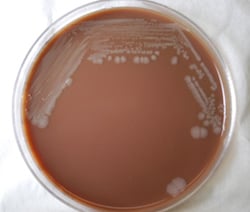Information for Health Care Workers

Colony morphology displayed by Gram-negative Burkholderia mallei bacteria, which was grown on a medium of chocolate agar, for a 72 hour time period, at a temperature of 37°C.
Etiologic Agent
Burkholderia mallei, a gram-negative bacillus.
Sequelae
Systemic invasion can occur with resulting chronic abscessation.
Diagnosis
The disease is diagnosed in the laboratory by isolating Burkholderia mallei from blood, sputum, urine, or skin lesions. Serologic assays are not available.
Trends
Glanders continues to be extremely rare in humans. In 2000, one case occurred in a research laboratory worker in the U.S. after accidental exposure.
While no national or state surveillance exists, the case-fatality rate is over 50% with traditional antibiotic treatment. Susceptibility data, however, suggest newer antibiotics should be efficacious.
Contact Us:
- Centers for Disease Control and Prevention
1600 Clifton Rd
Atlanta, GA 30333 - 800-CDC-INFO
(800-232-4636)
TTY: (888) 232-6348 - Contact CDC–INFO
 ShareCompartir
ShareCompartir



